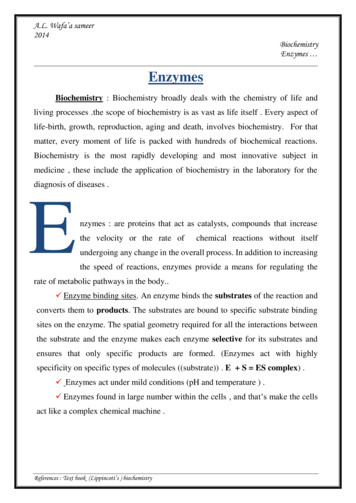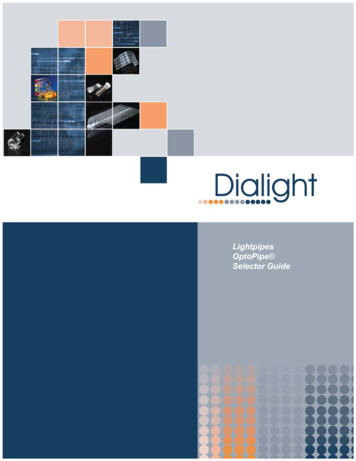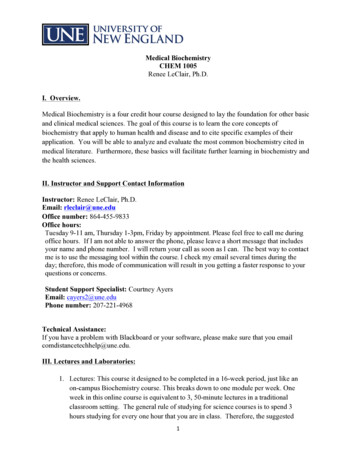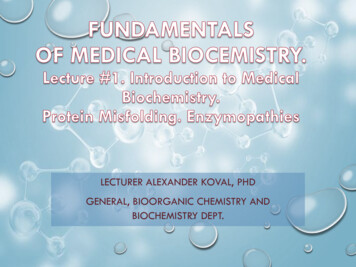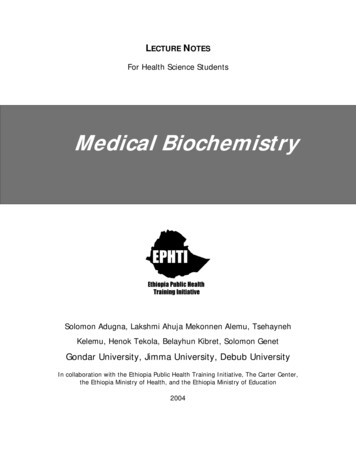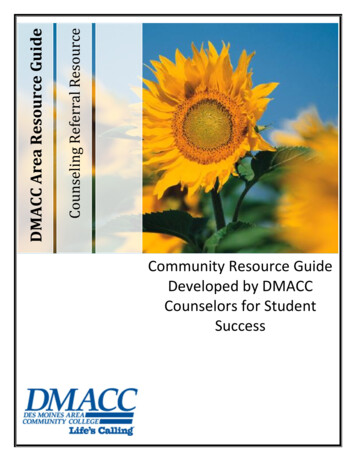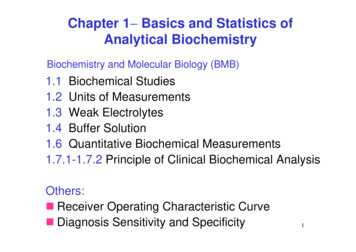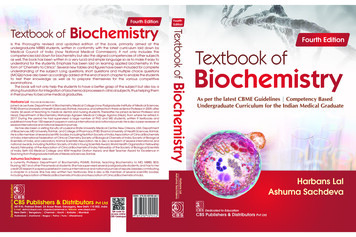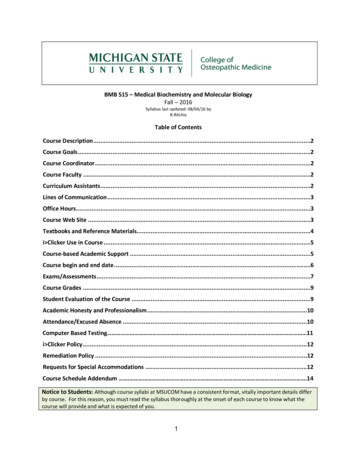
Transcription
BMB 515 – Medical Biochemistry and Molecular BiologyFall – 2016Syllabus last updated: 08/04/16 byR.RitchieTable of ContentsCourse Description .2Course Goals.2Course Coordinator .2Course Faculty .2Curriculum Assistants.2Lines of Communication .3Office Hours.3Course Web Site .3Textbooks and Reference Materials.4i Clicker Use in Course .5Course-based Academic Support .5Course begin and end date .6Exams/Assessments .7Course Grades .9Student Evaluation of the Course .9Academic Honesty and Professionalism .10Attendance/Excused Absence .10Computer Based Testing 11i Clicker Policy .12Remediation Policy .12Requests for Special Accommodations .12Course Schedule Addendum . . .14Notice to Students: Although course syllabi at MSUCOM have a consistent format, vitally important details differby course. For this reason, you must read the syllabus thoroughly at the onset of each course to know what thecourse will provide and what is expected of you.1
Section 1 – Course InformationCourse DescriptionBMB 515 is a 2 credit hour course that provides students with a survey of the major biochemical eventsoccurring in normal cells and tissues. Where possible, examples will relate directly to human biology.The normal state will be described; abnormal conditions are considered insofar as they serve toilluminate the normal condition.Course Goals1. Present students with a survey of the major biochemical events that occur in normal cells andtissues.2. Provide students with a vocabulary of terms encountered in other basic science and clinicalcourses.3. Provide students with an understanding of the principal biochemical mechanisms thatcontribute to normal homeostasis and the inherent capacity of the individual for themaintenance of health and recovery from disease.Please note that specific instructional objectives are provided within each lecture or other learningactivity of this course.Prerequisites (at college level): One year of organic chemistry and 1 semester of biochemistryCourse Coordinator(Note - Preferred method of contact is shown in italics)Name:Phone:Email:Address:MI 48038Raquel Ritchie, Ph.D.586-263-6296rritchie@msu.edu117-4 UC-4, MUC - 44575 Garfield Road, Clinton Twp,Course Faculty(Note - Preferred method of contact is in e:John Wang, Ph.D.515-353-9542wangj@msu.edu402C Biochemistry, ELCarol Wilkins, Ph.D.515-353-4927mindockc@msu.edu502B Biochemistry, ELCurriculum AssistantsName:Phone:Email:ELCheryl Luick517-884-3880luick@msu.eduMartha Faner, Ph.D.313-578-9669fanermar@msu.eduCG90, DMCJin He, M.D., Ph.D.517-353-0613hejin1@msu.edu116A Biochemistry, ELRaquel Ritchie, Ph.D.586-263-6296rritchie@msu.edu117-4 UC4, MUCDMCKatelyn Johnston517-884-9628appleto6@msu.eduMUCBeata Rodriguez - LEAD586-263-6799beata.rodriguez@hc.msu.edu2
Lines of Communication For administrative aspects of the Course: contact the course coordinator, Dr. Raquel Ritchie. For content questions relating to a specific lecture or topic: contact the faculty presenter for thatspecific portion of the course or your SE MI on-site instructor. For absences/missed exams (see excused absence information below)Office HoursOffice hours for each campus are announced in site-specific folders under the Content tab in the D2Lcourse website. Students are also encouraged: (a) to address questions and suggestions to instructorsvia the Email system; (b) to seek individual consultation with the lecturer or the on-site instructor byappointment throughout the semester; and (c) to use student led discussion board (see below).Questions concerning the course may be discussed individually by making an appointment with theCourse Coordinator, Dr. Raquel Ritchie, Room 117 UC-4 MUC, by phone 586-263-6296 or via e-mail:rritchie@msu.edu. The Course Coordinator is generally available by appointment.Course Web SiteThe URL for the Course web site is https://d2l.msu.edu/The course D2L site has these PERTINENT sections: News – Course-related communication to the class will be made here. You should check forannouncements on a daily basis. Syllabus – Contains the course syllabus with information about the instructional teams, textbooks,exam dates, grading system, rules and regulations, etc. This file can be found under the Contenttab of the Course website. Content – Problem Sets, Homework Assignments, self-study modules (SSM), and other courserelated materials. Communicate – Contains the course-related email system and the Discussion Forums. Discussion Boards – List of student “asked" questions organized by week and by lecture. Thediscussion board will be primarily student led. It is intended for students to use as a way tocommunicate with each other and teach each other. The BMB faculty will monitor the discussionboard periodically. It is highly recommended that you check the discussion forum prior to sending aquestion to faculty as it is very likely that you are not the only student with questions – yourquestion and others may already be available for your review – saving you time.Note: Although each visit to any section of D2L by an individual student is “tracked” by the computerand the instructors of the course will have access to such information, we do not intend to use it.3
Textbooks and Reference MaterialsRequiredRecommended BMB 515 Course Pack K Turnpenny, P. and Ellard, S. Emery’sElements of Medical Genetics, 14thed. Elsevier/Churchill Livingstone, Ferrier, D. Lippincott’sIllustrated Reviews:2012. [ISBN: 978-0-7020-4043-6]thBiochemistry, 6 ed. Rhoades, R. and Bell, D. MedicalWolters Kluwer/Lippincott,Physiology: Principles of ClinicalWilliams & Wilkins, 2014.Medicine, 4th ed. Lippincott, Williams[ISBN: 978-1-45117-562-2]& Wilkins, 2013. [ISBN: 978-1-60913 Wilkins, C. Understanding427-3]Biochemical Pathways: APattern RecognitionApproach. CognellaAcademic Publishing, 2017.[ISBN: 978-1-62131-250-5]Required Three On-line Tutorials (TT)covering amino acidstructures, nucleotidestructures, and carbohydratestructures Self-study module onGluconeogenesis (see courseD2L site)Other Instructional Material: The on-line tutorials are available on the BMB 515 courseMediaSite catalog on a sub-folder labeled “Tutorials”. Each tutorial title is preceded by“OPTIONAL” or “REQUIRED”. There are three on-line tutorials that are required and they arelabeled as REQUIRED. The other on-line tutorials labeled as OPTIONAL are available to you incase you need to review these concepts.Type of readings for the course: Required Reading: These are REQUIRED readings that you have to read even if it is notcovered in class. You will be tested on this content. These readings are best done afterthe class session in which it is assigned because it may be related to a lecture topic, butnot covered in class. Suggested/Clarification Reading: These are OPTIONAL readings. If anything in aparticular lecture or required reading is unclear please read these to clarify.Additional instructional materials, including the three required tutorials (TT) and the self-studymodule (listed above), required readings, problem sets, and computer-based instructional aides,may be provided in the learning centers of COM at each site, as links at the course website, or ashandouts at lecture sessions. These materials are intended to be an integral aspect of the course;instruction in some course objectives may be accomplished entirely through these exercises andexperiences, and thus might not be explicitly addressed during lectures. Students are stronglyencouraged and expected to make use of them.Opportunities to confirm your understanding: Problem sets and their answers will be providedon the course D2L site for sessions 1-30. The Problem Sets for the tutorials and for sessions 6 and13 are provided throughout the course pack. These problem sets are designed both to help thestudents grasp key concepts and connections and to provide practice in the skills and tasksdefined by the educational objectives. Some problems may resemble typical exam questions instyle and depth; others will be more open-ended or explorative. These problem sets will not begraded, but will provide students with an opportunity to assess their mastery of the objectivesand to identify concepts that require further study.4
i Clicker Use in Coursei Clickers will be used in this class. See In-Lecture i Clicker points on page 8 of this syllabus for moreinformation. An i Clicker 2 is required for this class. The mobile application, i ClickerGO, will not beallowed.In this course, i Clicker input may be used in the following ways: to provide practice withconcepts and principles, to stimulate discussion and/or to give in-lecture i Clicker questions.Questions may be posed at any time during the class hour. No make-up experiences will beprovided should you forget your i Clicker. The i Clicker will be the only mechanism to recordattendance during large group lectures. If the i Clicker is used to take attendance, you will be expected to arrive in class on timeand to stay for the duration of the assigned activity. If you bring your i Clicker and it fails during the lecture, please see the courserepresentative immediately after the lecture to inform us of the problem. NO points forattendance will be given unless you notify us at the time of the lecture.Please refer to additional i Clicker policy information provided in Section 2 of this syllabus.Supplemental Instruction (SI):Supplemental Instruction is an academic assistance program that utilizes peer-assisted study sessions.The SI sessions are regularly-scheduled informal review sessions in which students compare their classnotes, discuss assigned readings, practice problem solving, develop organizational tools, and predicttest items. The participants learn how to integrate course content and study skills while workingtogether. The sessions are facilitated by “SI leaders”, students who have previously taken the courses,done well in them and are model students. The main purpose of this program is to improve students’grades and their overall learning ability.Schedule for SI sessions:Thursday, 9/1: 5:00-7:00pm (Prepare for Quiz1)Friday, 9/2: 2:00-4:00pm (Review of the first week content)Friday, 9/9: 4:00-6:00pm (Review of the second week content and Prepare for UE1)Friday, 9/16: 2:00-4:00pm (Review of the third week content and Prepare for Quiz2)Friday, 9/23: 4:00-6:00pm (Review of the fourth week content and Prepare for UE2)Please make sure to check the BMB 515 D2L site under the “Supplemental Instruction” tab for updatedinformation on SI schedule and room numbers for different sites.Course-based Academic SupportThe value you derive from this course (and those that follow it) will depend on many factors, but mostimportantly the amount of time and effort you put into it. In undergraduate courses, students oftenconcentrate on just getting through the next exam or individual courses. But medical education isdifferent because it is cumulative. Study for understanding, not just short term memorization. This willallow you to understand concepts and carry them forward with you to the next step in your medicaleducation.You are strongly urged to: Consult the course D2L web site frequently to see announcements and to access various study aids(e.g., follow-up to problem sets, practice exam questions, and answers to frequently askedquestions). Complete the preparatory work assigned for each lecture session; this includes working through the5
online modules, problem sets or any other advance study activities.Attend every lecture and lab session.Actively annotate your Course Pack as you prepare for each class session, as each class sessionprogresses, and also during your follow-up study.Complete the follow-up (supplemental) reading and self-study exercises as directed in the CoursePack and on the D2L web site.Use the practice exam questions (posted on D2L prior to each exam) to help guide your review andpreparation for exams. Do NOT wait until the day before an exam to look at these practice examquestions. Instead, start using them several days prior to each exam to help guide your review andexam preparation.Each member of the teaching team has a well-deserved reputation for being approachable and forhelping students achieve success. Avail yourself of the opportunities for help provided by thecourse faculty -- in person, via e-mail, and at scheduled help sessions or call them to schedule anappointment time.The time immediately before or after a course lecture is often too hectic to provide a goodopportunity to get help from course instructors. By contrast, lab sessions (especially at the endwhen some of the students have already departed) or scheduled office appointments provide anexcellent time to ask questions of course faculty.Keep in mind that you can contact course faculty by e-mail with your questions. Note: Wheneveryou pose a question by e-mail, include what you THINK the answer is. This makes it much easier forthe instructor to either confirm your understanding and/or offer clarification.Face-to-face contact with faculty at lecture sessions -- In addition to the faculty person giving alecture, one or more of the course faculty regularly sit in on course lecture sessions at each site. Thisprovides you with an opportunity to pose a quick question or to request a personal meeting withyour local campus faculty. E-mail is also a good way to set up a personal meeting with a particularfaculty member.Study groups - Many students find it beneficial to study with one or more partners, and we stronglyencourage this activity. Studying together can be efficient (what one student doesn't understand,another one will), stimulating (personal interaction can help keep you focused and alert), andmotivating (commitment to a partner supplements self-discipline). We encourage you to study withsuitable partners. We caution you, however, to avoid study groups that turn into "gab fests" orwhere one or two students do all the talking. Remember, you may THINK you understand a conceptwhen you hear someone else explain it, but you'll KNOW you understand the concept only whenYOU can explain it to someone else. So, make sure you get to talk in your study group!Caution: Scribe note services are not sanctioned by MSUCOM and are not endorsed by the coursefaculty. Course faculty assume no responsibility whatsoever for errors in the "scribe notes". It isunwise to expect the "scribes" to substitute for your own attendance in lecture or lab, your ownnote taking, or your own studying.Additional academic support resources can be accessed at:http://com.msu.edu/Students/Academic Development/index.htmIn summary, the course faculty are here to facilitate your learning. The large number of students in thiscourse (about 300) necessitates a degree of formality. Also, since your schedules are very full, we mustadhere rigidly to the lecture, small group and lab times assigned to this course. However, within theseconstraints, the needs of individual students will be accommodated whenever possible. Please feel freeto contact the Course Coordinator with any personal issues you may have involving this course.Course begin and end datesBMB 515 begins on August 29, 2016 and ends on December 5, 2016. See addendum for detailed daily6
course schedule.Evaluation of Student Performance:The educational objectives defined for each section of this course, as outlined in the course pack, willserve as the basis for evaluating student performance. Mastery of these objectives will be expectedwhether those topics have been discussed in lecture sessions or explored using other resources(required tutorials, required readings, problem sets). Student attainment of these objectives will beevaluated using two quizzes, two exams, two homework assignments, and points from in-lecturei Clicker questions (see Table below).a. Each quiz will contain 7 questions, to be completed in the first 10 minutes of the class on thedate stated, in the lecture venue. The quizzes will be administered using your personalcomputer-based testing device. The detailed “BMB Quiz Protocol” will be posted on the BMB515 D2L site under the “Content” tab.b. Unit exams 1 and 2 (see Table below)Exams/AssessmentsThere will be a total of 2 exams, 2 quizzes, 2 homework assignments, and points from in-lecture i Clickerquestions in BMB 515 this year. Grades in BMB 515 are determined by your accumulated score of thefollowing graded assignments in the table below:AssessmentProjected PointsQuiz #1Fri., 9/02/167Sessions 1 through 6 plus the 3tutorialsUnit Exam 1Mon., 9/12/1651Sessions 1 through 14, the 3 tutorialsand the GNG self-study moduleQuiz #2Mon., 9/19/167Sessions 15 through 22Unit Exam 2Mon., 09/26/1648Sessions 1 through 30, CAS, the 3tutorials and the GNG self-studymoduleIn-Lecture i Clicker8/29/16-9/23/163Content from lecture(s) and CASHomework Assignment 19/26/16-10/5/164Sessions 14 through 28Homework Assignment 212/01/16-12/05/165Sessions 1-30 and CAS; and OST 551Week 14 EBM: Basic Science Cases andsearching the literatureTOTAL POINTS1257Material to be Covered
ON-LINE Graded Homework 1: The purpose of homework assignment 1 is to help students develop theability to integrate basic science concepts from BMB 515 as well as other courses in the curriculum toanswer patient questions in layman's language.You must go to the D2L BMB 515 course site. Under the “Content” Tab, there is a folder entitled “Online Homework Assignment 1”. The Homework Assignment will consist of a short essay response.Further details and instructions, including how to submit your answers, will be provided with thehomework assignment. The homework assignment will be available for ten days: The Homework Assignment will be available from noon Monday, September 26, 2016 until11:30 pm Wednesday, October 5, 2016.Part of your coursework, such as aggregate class data, may be used for the purpose of research onpedagogical development. No information will be identified with any individual. If you have anyquestions or concerns regarding this matter please feel free to contact the course coordinator Dr.Raquel Ritchie.ON- LINE Graded Homework 2: This homework assignment will be carried out in conjunction with theOST 551 session on Thursday, December 1, 2016. Two key educational goals are associated with thisassignment: (1) to develop skills in searching the medical literature related to a clinical case so thatdeficiencies in distinct metabolic pathways can be delineated and distinguished; and (2) to illustrate theinter-connectedness of metabolic pathways, giving rise to similar but not identical clinical presentationsand lab results. At the conclusion of the OST 551 session on December 1, please go to the D2L BMB 515course site. Under the "Content" tab, access the folder entitled "On-line Homework Assignment 2." TheHomework Assignment will consist of five multiple-choice questions related to biochemical pathwaysaddressed in the clinical case of OST 551. Further details and instructions, including how to submit youranswers, will be provided with the homework assignment. The homework assignment will be availablefor four days: The Homework Assignment will be available from 5 pm, Thursday, December 1, 2016 until11:30 pm Monday, December 5, 2016.In-Lecture i Clicker points: Each student can potentially earn a maximum of 3 points (counting towardthe 125 total points in the Course) by coming to class and participating in the i Clicker session.a. There will be one i Clicker session every day for which there is a lecture in this Course except fordays in which there is a quiz (a total of 15 i Clicker sessions). Note that this includes the BMB515 CAS session.b. THREE of these i Clicker sessions will have one point associated with the session. However, thethree sessions that count will be disclosed only at the end of the course.c. To get the point associated with an i Clicker session, you will have to answer at least one of the"scientific content" questions in the i Clicker session correctly.d. Each i Clicker session will begin with a "checking the date" question, which does not count as a"scientific content" question.e. The number of "scientific content" questions for each i Clicker session may vary.f. The i Clicker session may take place at any time during the class hour.g. The answers to the i Clicker questions will be posted on the course D2L site by 5 pm onthe day of the i Clicker session.h. No make-up experiences will be provided should you not attend a session, if you forget youri Clicker or if your i Clicker does not work.8
i.For example, if you come to class and participate in an i Clicker session that counts, you mayreceive one point — as long as you answer at least one of the “scientific content” questionscorrectly for that session. If you attend class everyday and participate in all of the i Clickersessions, you significantly increase your chances of earning the maximum 3 points for thesei Clicker sessions.Clinical Application Session (CAS): There will be one Clinical Application Session that will take place onFriday September 23, 2016 specifically relating to material presented within the BMB 515 course (pleaserefer to the corresponding BMB 515 lecture schedule). This session will be local and it willnot be broadcasted or recorded (no Mediasite recording will be available). Due to the nature of thislearning activity, there will be no makeup opportunities provided.SiteTime of SessionSession8:00 – 9:50 amSession 110:00 – 11:50 amSession 2EL House #1EL House #2EL House #3EL House #4East LansingLecturerRoom numberDr. WangDr. WilkinsDr. WangDr. WilkinsE202102 ConradE202102 ConradDMC10:00 – 11:50 amOne SessionDr. FanerG029MUC10:00 – 11:50 amOne SessionDr. RitchieUC3 208Course GradesA total of 125 points can be derived from the two exams, two quizzes, two homework assignments,and points from in-lecture i Clicker questions (see table on page 7) P-Pass—means that credit is granted and that the student achieved a level of performancejudged to be satisfactory by the instructor. To obtain a “P” grade for this course, a studentmust obtain 70% or a total of 87 points. N-No Grade—means that no credit is granted and that the student did not achieve a levelof performance judged to be satisfactory by the instructor. A student who accumulatesless than87 points or an accumulated score below 70% will receive an “N” grade. Remediation - Since all of the courses in the MSUCOM curriculum are required, any studentreceiving an “N” grade must remediate the course. Consistent with COM policy, theremediation opportunity for BMB 515 will be by examination. The Remediation Exam willconsist of 60 questions, comprehensive for the course. Passing is 70%. Students failing theRemediation Exam will need to retake BMB 515. Please refer to the remediation policyinformation provided in Section 2 of this syllabus for information on College requirementsand eligibility determination.Student Evaluation of the CourseWe want your feedback on how to improve this course. Informal Feedback: Feel free to approach the Course Coordinator, Dr. Raquel Ritchie, or any of9
the other course faculty with your reactions and suggestions. Or write out your comments andemail them to the Course Coordinator or Faculty. From time to time, we may also convenefocus groups of students, as an additional way to elicit your opinions and suggestions. Formal Evaluation: In addition to the above, we ask every student in the class to completeformal on-line course evaluation upon conclusion of the course. Student course evaluationsare highly recommended. Student feedback provides Course Coordinators with valuableinformation regarding their performance, the performance of their colleagues, and the qualityof the course. The information gained from these evaluations is used to continuously improvefuture offerings of this course. Students can access the evaluation system at:http://kobiljak.msu.edu/Evaluation/UnitI II.html . Your participation in this important processis greatly appreciated. SIRS Evaluations – You are not required to complete the course evaluations available to youvia SIRS. If you would like to opt out of the ability to evaluate this course using SIRS, login tosirsonline.msu.edu, click the link to the survey, then select button at the bottom that says“Decline to Participate.”Section 2 – PoliciesAcademic Honesty and ional Development/Statement on Professionalism.htmEvery student is responsible for their behavior and is expected to adhere to all MSU and MSUCOMpolicies of academic honesty and professionalism. If there is any instance of academic dishonesty orunprofessionalism discovered by a member of the faculty, administration or staff, it is his or herresponsibility to take appropriate action.Such action may include, but is not limited to: giving a failing grade, referring a student for judicialreview, directing the student to the Associate Dean of Student Services, and any other actions outlinedin the Medical Students’ Rights and Responsibilities R-Offical-Document-Final.pdfAbsences from Mandatory Class Sessions, Examinations, Assessments and ActivitiesMSUCOM students are expected to attend all mandatory class sessions (e.g., lectures, laboratories,group activities) and take all examinations/assessments during their originally scheduled times. If this isnot possible an excused absence may be requested.Excused absences will not be given to all who make a request. If a request for an excused absence isdenied, the student will receive a zero (0) grade for the mandatory session or examination/assessmentin question, which may result in the issuance of an “N” grade in the course.An excused absence does not relieve the student from responsibilities for missed mandatory classsessions and examinations. It is highly possible that an excused absence will not be granted for amandatory class session due to scheduling of equipment and faculty. If one of these mandatory sessionsis missed, even though an excused absence is granted, and cannot be made up, the student will receive azero(0) grade for the event and may be required to repeat the course at its next offering.10
Personal Emergencies:To obtain an excused absence, complete the Excused Absence Request form found on the student portal.A personal emergency is typically defined as the death of an immediate family member, serious illness,automobile accident and/or hospitalization. Situations including, but not limited to: failure to be ontime, conflicting appointments and failure to provide proper identification will not be considered apersonal emergency, and requests based upon these situations may be denied.If an examination/assessment or other mandatory experience is missed due to medical reasons, amedical provider’s written confirmation may be required before the request is considered.Advance Notice of Absence Available:A student must submit his or her excused absence via the Excused Absence Form at least one week inadvance of any scheduled mandatory class session or examination/assessment. Requests for excusedabsences regarding weddings, family celebrations and vacations will be denied.Conferences, Conventions, Meetings, College Sponsored Activities:If a student wishes to attend a conference, convention, meeting, or college sponsored activity which willcause him or her to miss a mandatory class [session(s) and/or examination(s)], he or she must c
Prerequisites (at college level): One year of organic chemistry and 1 semester of biochemistry . Course Coordinator (Note - Preferred method of contact is shown in italics) Name: Raquel Ritchie, Ph.D. Phone: 586-263-6296 . D. Lippincott's Illustrated Reviews: Biochemistry, 6th ed. Wolters Kluwer/Lippincott, Williams & Wilkins, P2014. [ISBN .
